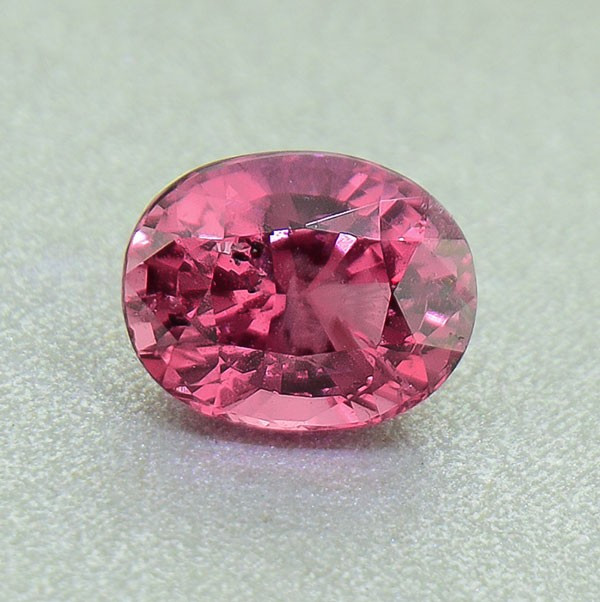
パパラチャサファイアとは?この希少な宝石についてすべて学びましょう
 サファイアといえば、ブルーサファイアがしばしば注目を集めるのは周知の事実です。しかし、パパラチャサファイアも、空色のサファイアと同じくらいまばゆい輝きを放ち、その価値は計り知れないことをご存知でしたか?
サファイアといえば、ブルーサファイアがしばしば注目を集めるのは周知の事実です。しかし、パパラチャサファイアも、空色のサファイアと同じくらいまばゆい輝きを放ち、その価値は計り知れないことをご存知でしたか?
神聖な蓮の花にちなんで名付けられたパパラチャサファイアは、宝石界で希少価値の高い宝石です。オレンジとピンクの鮮やかな色合いを持つパパラチャサファイアは、きっと息を呑むほどの美しさです。
夏らしい色合いのこの石は、一般の人々から王族まで、幅広く愛されています。2018年には、ユージェニー王女が美しいパパラチアの婚約指輪を贈り、話題をさらいました。
では、謎に包まれたパパラチャサファイアとは一体何なのでしょうか?そして、なぜ宝石ファンの間でこれほど人気があるのでしょうか?この包括的なガイドでは、夕焼け色のサファイアの歴史、意味、そして様々な物理的特性について詳しく掘り下げていきます。
まずは基本から始めましょう。
パパラチャサファイアとは何ですか?
パパラチャサファイアはコランダム鉱物に属します。この美しい宝石は、サファイアの中でも非常に希少で、他に類を見ない希少性を持っています。
一般的には「ピンク」または「オレンジ」サファイアに分類されますが、パパラチャサファイアには両方の色が含まれています。未処理で入手困難な本物のパパラチャサファイアは、サーモンピンクのような色合いをしています。 
パパラチャサファイア自体よりもさらに希少なのが、崇敬を集めるスターパパラチャです。他のスターサファイアと同様に、スターパパラチャは滑らかで磨かれた形状により、星のような輝きを放ちます。需要は高いものの、この品質のサファイアを生み出すものは多くないため、スターパパラチャは希少です。
基本的な事項を説明したので、パパラチャ サファイアの産地とその形而上学的特性について探ってみましょう。
パパラチャの意味と歴史
パパラチャサファイアは、ただ単に驚くほど美しい宝石というだけではなく、歴史と重要な象徴性に満ちた貴重な宝石でもあります。
パパラチャ石は、約2000年前にスリランカで初めて発見されました。最大のパパラチャ鉱床はスリランカにありますが、サーモンピンクのサファイアはベトナム、タンザニア、マダガスカルからも産出されます。
意味
パパラチャという名前は、シンハラ語の「パドマラガ」(水中の蓮の花)に由来しています。その名の通り、パパラチャサファイアは、人生を豊かにする、精神的、感情的、そして健康的な多くの望ましい性質を象徴しています。
例えば、パパラチャストーンは心と精神の純粋さを象徴しています。この素晴らしい宝石の力によって、魂を蝕むあらゆる力から解放され、心と精神は再び軽やかで自由で無垢な状態に戻ります。まるで内なる子供が家に帰ってきたかのようです。
洞察力と意志の力を得たいと願うなら、パパラチャストーンを所有することで、知恵と決断力が強化されます。鋭い判断力を養い、設定した目標を必ず達成できるようになります。これらの資質は、個人としても仕事においても、成長を促してくれるでしょう。
これらの宝石は、名誉を築き、幸運を招き、身に着ける人に長寿と健康をもたらします。頻繁に旅行する人にとって、パパラチアは旅のあらゆる危険から身を守るお守りとして役立ちます。そのため、これらの希少なサファイアは、一人旅の方への贈り物に最適です。

精神的な意義
パパラチャはチャクラヒーリングとエネルギーバランスにも深く関わっています。この石は、おへそのすぐ下にある仙骨チャクラに対応しています。仙骨チャクラは、情熱の中枢を活性化し、生殖器系を調整し、性欲、創造性、冒険心を刺激する役割を担っています。
仙骨チャクラが詰まると、生殖機能の問題、腰痛、性欲減退などの症状が現れる可能性があります。膀胱や腎臓にも問題が生じる可能性があります。感情面では、創造力が燃え尽き、性生活に不安を感じることもあります。
ありがたいことに、パパラチャサファイアには仙骨チャクラのバランスを整える力があります。パパラチャの淡いピンク色のトーンは愛と創造性を体現し、内なるミューズとロマンチックな関係を育みます。性的エネルギーが整い、再び自分の体に心地よさを感じられるようになるでしょう。
一方、サファイアの燃えるようなオレンジ色は、情熱的な献身と生きる力を表しています。この宝石は、人生がもたらすあらゆるものを体験させてくれます。意識の新たな高みに到達し、ネガティブなエネルギーを払いのけることができるでしょう。
パパラチャが並外れた特性を持っていることは明らかです。それでは、その美しい色彩についてお話しましょう! 
パパラチャの色の範囲
パパラチャサファイアはオレンジやピンクといった色調ですが、明るい色から中間色の幅広いスペクトルを呈します。この宝石の色は「ピーチ」「サンライズ」「アプリコット」などと呼ばれることが多いですが、本物のパパラチャサファイアは太陽光にさらされるとサーモンピンク色になります。
パパラチャサファイアの並外れた色は鉄とクロムの微量元素から生じており、次のセクションでこれについて詳しく説明します。
パパラチャ宝石には幅広い色の範囲があるため、サファイアを購入する際には、お気に入りの色合いを考慮するとよいでしょう。
例えば、中程度の彩度とパステルカラーのパパラチャストーンは、その均一な色調が目を楽しませるため、トレンドとなっています。本物のパパラチャサファイアも非常に貴重であることを覚えておいてください。
しかし、同じ色合いの宝石は二つとありません。それぞれの宝石が独自の輝きを放ちます。蓮の花のように、パパラチアの宝石はどれも、きらめくオレンジピンクの筋で魅了され、心を奪われます。 
仕様
これまで、パパラチャの歴史、象徴性、そして色の範囲について説明してきました。次は、パパラチャの物理的特性について詳しく見ていきましょう。
メイクと構成
他の鉱物コランダムと同様に、パパラチャサファイアの成分は酸化アルミニウム、またはアルミナと呼ばれる化合物です。すべてのサファイアには、鉄、チタン、クロム、バナジウム、マグネシウムなどの微量元素が含まれています。これらの元素の独特な組み合わせが、サファイアの色の多様性を生み出します。
ほとんどのサファイアは鉄とチタンを含むため青色ですが、パパラチャサファイアは鉄とクロムを含むためサンライズのような色合いになります。クロムはステンレス鋼によく使用されますが、パパラチャサファイアの鮮やかなピンク色もクロムによるものです。
その化学組成のおかげで、この石はモース硬度9.0という驚異的な硬度を誇ります。19世紀にドイツの鉱物学者フリードリヒ・モースによって考案されたモース硬度は、鉱物の硬度と耐傷性に基づいて1から10の段階で評価されます。
ちなみに、パパラチャサファイアは文字通り石工用ドリルビットよりも硬いんです!とはいえ、壁に穴を開けるのに使うのはおすすめしませんよ!
パパラチャサファイアは、疑いようもなく驚くほど丈夫な宝石です。パパラチャサファイアの密度を上回る鉱物は、なんと10%のダイヤモンドだけです。宝石のジュエリーを日常的に身に着けたい方にとって、パパラチャサファイアはどんな状況にも耐えうる、耐久性に優れた宝石です。
ですから、パパラチャが婚約指輪のセンターストーンとして流行している理由は簡単にわかります。
カット
サファイアは六方晶系の結晶構造を持つため、摩耗や損傷に強い様々な形にカットすることができます。婚約指輪、ペンダント、その他のジュエリーでは、一般的に楕円形、円形、クッション型が用いられます。
もちろん、自由奔放なパパラチャは、異なるルールに従うことを好みます。これらの希少なサファイアを非対称にカットすることで、可能な限り多くの素材が保持されます。結局のところ、パパラチャのような貴重な宝石の場合、素材が多ければ多いほど価値が高まります。
ですから、次にパパラチャサファイアを買うときは、その変わった形に驚かないでください!それは、より高品質なサファイアを手に入れられるということを意味します。 
明瞭さ
宝石を購入するときは、必ず「透明度」と呼ばれるものに注意してください。
クラリティは、インクルージョン、フラクチャー、そしてキズが宝石の外観と構造にどの程度影響を与えるかを評価します。 インクルージョンとは、宝石の中に閉じ込められた結晶、ガス、または液体の粒子を指します。パパラチャサファイアのような希少で貴重な宝石の場合、インクルージョンの存在は価値を高めます。なぜなら、これらの結晶化した粒子は、誰もが魅了される天上の美しさと深みを与えるからです。
では、透明度は内包物とどのように関係しているのでしょうか。また、サファイアを購入する際に透明度を念頭に置くべき重要な要素なのはなぜでしょうか。
そうですね、クラリティグレードは、宝石がどれだけ「目に見えてきれい」か、つまり透明度を測るものです。宝石のクラリティが高いほど、内包物が肉眼で見えやすくなります。パパラチャサファイアの場合、これは良いことです。
言い換えれば、宝石が不透明または「曇っている」ほど、価値は低くなります。
透明度の高いパパラチャサファイアは高級ですが、この宝石自体がすでに非常に希少であるため、購入する際に透明度を妥協しなければならない場合もあります。
それでも、パパラチアはルビーよりも透明度が高く、値段の付けられない宝石です。目立った内包物の有無に関わらず、この魅力的な宝石にきっと驚嘆し、心を奪われることでしょう。
サイズ
サファイアを購入する際は、サイズとカラット重量も考慮する必要があります。でも、ちょっと待ってください。これらは同じ意味ではないでしょうか? 実は、その逆です。
宝石のサイズと重量は同義語として使われますが、これらは異なる基準です。
宝石のサイズはミリメートルで測られ、重量はカラットで計算されます。参考までに、1カラットは200ミリグラムに相当します。
パパラチャサファイアのサイズは、3~11ミリメートルと幅広い範囲で販売されることが多いです。一般的に、宝石が大きいほど価格が高くなります。もちろん、大きな宝石に目に見える内包物が多い場合は別ですが、大きなダイヤモンドであっても高額は付きません。
カラット重量
重量に関して言えば、ほとんどのパパラチャサファイアはルビーと同程度です。ほとんどが2カラット(400ミリグラム)未満です。この重量を超える石は極めて稀です。
幸運にも5カラットを超えるパパラチャを手に入れられたら?オークションに出品する価値のある、世界クラスの宝石を手に入れたことになります。
では、世界最大のパパラチャサファイアは一体どれほど重いのか、気になりますか?信じられないかもしれませんが、この巨大な宝石の重さはなんと100.18カラット(20,036ミリグラム)!この壮大な宝石は現在、ニューヨークのアメリカ自然史博物館に収蔵されています。

パパラチャサファイアの価格
パパラチャサファイアの主な仕様について説明したので、次は価格についてお話しましょう。パパラチャサファイアは非常に希少であるため、エメラルドやルビーと同じくらい価値があります。
多くの人にとって、これらの希少な宝石は、その高価格ゆえに手の届かないものとなっています。しかし、必ずしもそうとは限りません。
これらのユニークな宝石の価格を設定する際には、いくつかの要素が関係してきます。
サファイアの大きさはどれくらいですか?
宝石の品質はどうですか?
石はどのようにカットされ、磨かれたのでしょうか?
色は彩度が高いですか?
色彩について言えば、深みのある鮮やかな色調のパパラチャ サファイアの方が一般的に人気が高く、そこでサファイアの処理が重要になります。 
サファイア処理とは、サファイアの透明度と色を高めるプロセスで、通常は加熱処理を行います。標準的な方法の一つにベリリウム拡散処理があります。これは複雑な処理で、高温下でサファイアにベリリウムを拡散させることで、石の色合いを際立たせます。
この方法により、より鮮やかな色彩が生み出されますが、その結果、処理されたサファイアの価値は低くなると考えられています。
こうした様々な要素と基準のおかげで、パパラチャサファイアは1カラットあたり1,000ドルから20万ドルの価格で取引されます。ただし、大粒でミディアムトーン、高透明度、そして未処理の宝石はより高値で取引されることを覚えておいてください。
もちろん、信頼できる宝石代理店から直接石を購入すれば、よりお得に購入できます。

適切なパパラチャサファイアの選び方
ついに、バーチャル・パパラチャ・サファイア・ツアーも終わりを迎えました!この美しい宝石に日が暮れる前に、少し振り返ってみましょう。
ご存知の通り、パパラチャはただ輝く「ピンクオレンジ」のサファイアだけではありません。このユニークな宝石は、豊かな歴史、意味、そして色彩の幅を持っています。カット、透明度、サイズ、重量、そして価格も実に多様です。
どのパパラチャ宝石を選ぶかを決める際には、「完璧な」サファイアというものは存在しないということを理解してください。ご自身が最も重視する特徴、そしてご自身のニーズや希望に合致する特徴について考えてみてください。
本物のパパラチャサファイアを見つけることが、あなたのリストの一番上にあるかもしれません。あるいは、高いクラリティグレードの宝石をお探しかもしれません。あるいは、予算を抑えながらも価値の高いものをお探しなら、処理済みのパパラチャがぴったりかもしれません。
どのような基準でお選びいただいても、パパラチアの宝石はどこへ行っても注目を集めること間違いなしです。何と言っても、これらの希少なサファイアは蓮の花の生命力と輝きを宿しているのですから。
それで…何を待っていますか?
今すぐ当社のパパラチャ サファイアのセレクションをご覧ください。
Gemstone Encyclopedia検索
最新記事
鮮やかな赤い模様と文化的意義で珍重される希少な宝石、チキンブラッドストーンの歴史、特性、価値、お手入れのヒントをご紹介します。
8th Dec 2025
ゲイラス石は、乾燥しやすいため白濁しやすい希少鉱物で、主に工業用途で使用されています。この完全ガイドで、ゲイラス石の歴史、特性、用途、そして特徴をご覧ください。
7th Dec 2025
チオライトは、氷晶石に似た、無色から白色の希少鉱物です。宝石としては非常に希少で、限られた産地からしか産出されません。チオライトの用途、歴史、価格、特徴についてはこちらをご覧ください。
5th Dec 2025
記事のカテゴリ
How To's is where you will find helpful articles from gem Rock Auctions on how to cut gemstones, select gemstones and buy gemstones.
9記事数

